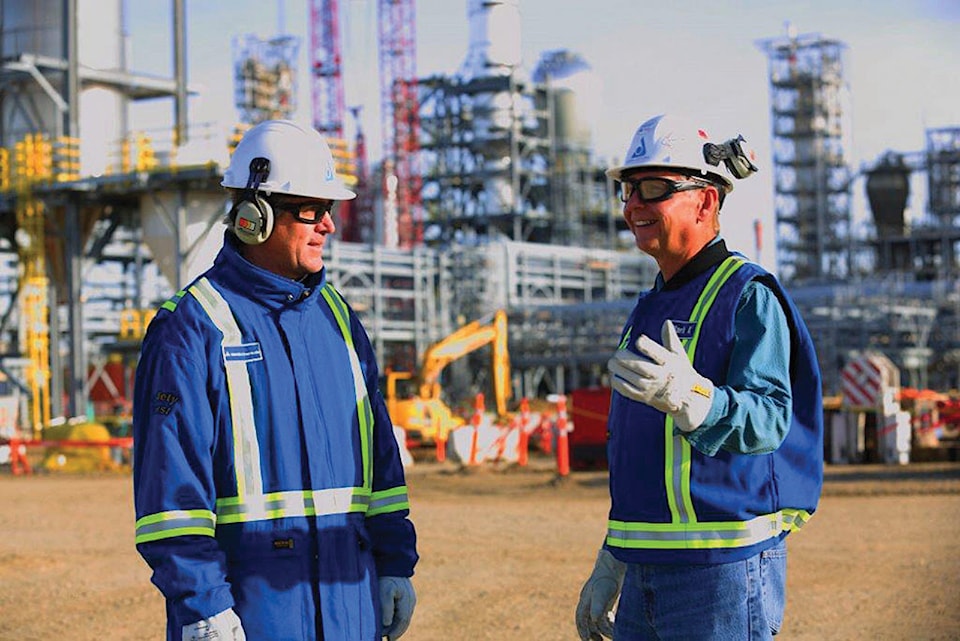The petrochemical giant spent $1 billion on its latest venture, adding a third world-scale polyethylene reactor to its Polyethylene 1 (PE1) plant.
For the company, the expansion establishes its credentials as a cutting-edge polyethylene producer in a competitive international field. Production will be boosted by 40 per cent to 3.5 billion pounds of polyethylene a year.
For Alberta and, specifically Central Alberta, Nova Chemical’s polyethylene ambitions have provided a much-appreciated economic windfall.
Forty to 60 per cent of the project’s capital costs stayed in Alberta.
Primary contractor Ledcor alone, spent about $160 million in salaries.
More than $30 million was spent locally on concrete, building supplies, equipment rentals, electrical and concrete accessories, fuel and site services. The 280-tonne reactor, that forms the heart of the expansion was manufactured by Tofield’s KNM Process Group Inc.
“It was really good to see pieces of equipment like that built right in Alberta,” says Joffre site leader Rick Van Hemmen.
“There’s been a lot of focus locally as well in terms of what was spent local this project,” Van Hemmen says.
About 35 per cent of Ledcor’s workforce, on average, was sourced locally.
About two million person hours of labour — the equivalent of a year’s worth of full-time work for 1,000 people — went into construction.
It has taken more than three years to get to the commissioning stage. A workforce that peaked at 800 has strung enough wiring to reach the Montana border. There is enough piping to reach Innisfail.
When the plant is up and running about 60 full-time jobs will be created, roughly split between Nova and contractors.
Final systems testing is now underway and the first production batches of tiny white polyethylene pellets will be spit out next month.
Over the next few months, production will be gradually ramped up to its target one billion pounds per year through next year.
Pellets produced will be loaded onto railcars and transported to markets across North America. Percentages vary, but typically 60 to 80 per cent of the polyethylene remains in North America. Of that, 10 to 20 per cent stays in Canada. The rest is sold internationally, mostly to Asia.
A major advantage of the expansion is an improvement in efficiency at plant level.
“What this gives us an opportunity to do now that we have three reactors is to dedicate each featured reactor to a smaller selection of our product slate. (That) allows all of our processes to run a little more efficiently as a result.”
Working in Nova’s favour on the business side, is that it’s polyethylene plant is among the first new builds coming on to the market, beating out a number of other competitors.
“That will be very helpful for us in positioning the product in places where we can get the most (profit) margin. But there are a number of other projects in North America (especially around the U.S. Gulf Coast) that will come on line in the next two to three years.
“We’re happy to be near the front end of this curve.”
Interesting economics have been created by the current energy market, where both oil and natural gas prices are at close to rock bottom.
Nova Chemical’s processes are powered by massive amounts of natural gas, so low prices in that feedstock is helpful.
Low oil prices are the opposite. Polyethylene pricing is based on the margins of higher-cost producers who use oil as a feedstock.
“When crude price is down, product prices in the petrochemical industry tend to be down. All that means is that our margins are smaller.”
“But because gas prices are still quite a bit lower than oil price in terms of petrochemical feedstock we still have healthy margins for our business right now.”
The polethylene expansion will boost greenhouse gas emissions — in Nova’s case carbon dioxide, methane and nitrous oxide — by about two per cent. But improved technology and facility optimization means emissions per pound of product will be sliced by eight per cent.
Also ongoing is a $250-million furnace refurbishment project is in progress for E-2, one of two ethylene reactors on site. Five of nine furnaces will be upgraded at that time.
Once that done, a phase 2 project to upgrade the remaining furnaces will be considered.
A major maintenance turnaround project at PE1 is scheduled for next fall.
Those are just the big projects to boost growth and improve production. Nova spends in the neighbourhood of $100 million a year reliability, responsible care and production improvements.
The 900-acre Joffre site also includes an Innovene linear alpha olefins (which can be used in polyethtylene among other applications) operation and a co-generation plant.
pcowley@www.reddeeradvocate.com
